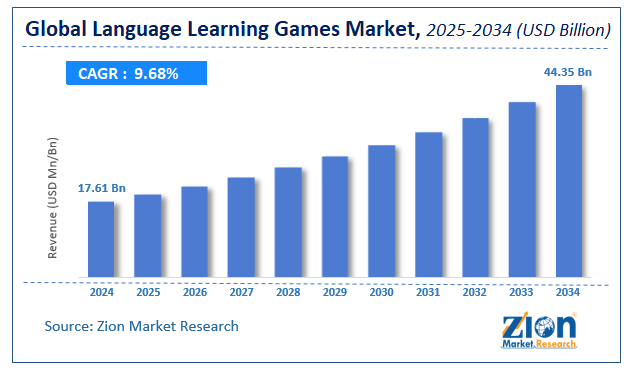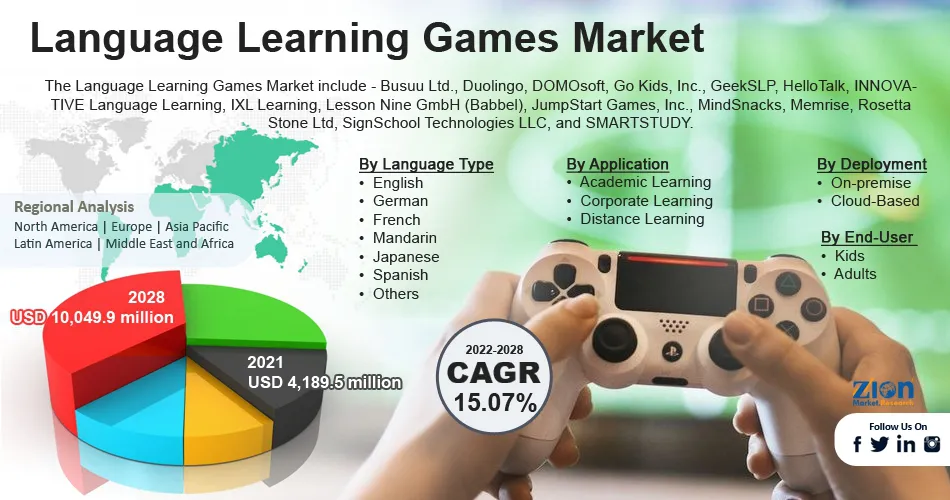Language Learning Games Market Size & Share Report, Growth, Trends, 2028

Language Learning Games Market By Language Type (English, German, French, Mandarin, Japanese, Spanish, and Others). By Deployment (On-premise and Cloud-Based). By Application (Academic Learning, Corporate Learning, and Distance Learning). By End-User (Kids and Adults), And By Region - Global And Regional Industry Overview, Market Intelligence, Comprehensive Analysis, Historical Data, And Forecasts 2022 - 2028
The global Language Learning Games Market size valued USD 4,189.5 Million in 2021 and to rise to USD 10,049.9 Million by 2028 at a CAGR of 15.7%.
Language Learning Games Market Size
The Language Learning Games Market was worth around USD 4,189.5 million in 2021 and is estimated to grow to about USD 10,049.9 million by 2028, with a compound annual growth rate (CAGR) of approximately 15.7 percent over the forecast period. The report analyzes the Language Learning Games Market drivers, restraints/challenges, and the effect they have on the demands during the projection period. In addition, the report explores emerging opportunities in the language learning games market.
Language Learning Games Market: Overview
Learning games relieve the learner's fear or pressure to make mistakes, making the learning process more enjoyable. When it comes to studying and teaching a foreign language, games are indispensable. The increasing use of smartphones by individuals of all ages is likely to fuel the global language learning games market growth. Significant reasons, such as the dropping cost of mobile data and the availability of free internet access via Wi-Fi in many regions, are growing the number of internet users worldwide. Additionally, the rapid growth of 3G and 4G coverage is expected to enhance smartphone sales globally.
The development of innovative teaching methodologies is expected to drive the demand for language learning games even higher around the world. Moreover, the growing number of language learning game startups is expected to drive global language learning game market growth. The number of start-ups joining language learning platforms has increased, drawing a new population of language learners globally.
Covid-19 Impact:
Over the pandemic period, almost every industry in the world has suffered a setback. This is owing to significant interruptions in their respective production and supply-chain activities caused by multiple precautionary lockdowns and other restrictions imposed by governing bodies throughout the world. The global language learning games market is no different. Furthermore, consumer demand has subsequently fallen as individuals are now more focused on reducing non-essential spending from their separate budgets since the overall economic state of the majority of people has been adversely affected by this epidemic.
These factors are projected to weigh on the revenue trajectory of the global language learning games market throughout the forecast period. However, when regional regulatory bodies begin to relax these imposed restrictions, the global language learning games market is likely to rebound.
Language Learning Games Market: Driver
Language Learning Games are becoming more popular around the world
Language experts and analysts have shifted their focus away from developing individual linguistic abilities and toward using language to achieve the speaker's goals. Gaming-based learning is a new area of training that has gotten a lot of attention recently. Statistical surveying hub has recently announced the addition of a review to its enormous database, which provides a comprehensive overview of this rapidly expanding industry and allows readers to grasp both the current status of the market and its potential for future expansion. The language-learning gaming technique has gained in popularity among children over the last few years. The use of games in the learning process may be an extremely effective strategy, and these games are primarily geared to help students with very easy pronunciation, vocabulary, spelling, and verb conjugations. As a result, the popularity and adoption of language learning games are predicted to skyrocket over the projection period.
Increasing popularity of mobile-based games among children is one of the prominent factors driving the growth of the language learning games market across the globe. A recent study revealed that 91% of children in the U.S. from the age group between 2 and 17 play video games. Therefore, schools are using learning games to drive deep engagement with their students in the classroom. The growing necessity of reinforcing a positive learning environment in the classroom is expected to further drive the global language learning games market growth. Using games in the classroom provides a more positive and shared learning atmosphere among students. According to the study, 53% of teachers find these games helpful in stimulating positive collaboration among students. However, lack of awareness about language learning games in many countries may hinder the growth of this market globally. Nonetheless, the adoption of virtual reality (VR) in learning-based games will fuel the demand for language learning games in the coming years.
Language Learning Games Market: Restraint
The Expensive Cost of Producing Language Learning Games
The language learning games market has recently developed at an unanticipated rate due to the development of unique teaching methods. The price of raw materials, the market concentration rate, and the pricing trends of major suppliers all influence the cost of developing language learning games. Pricing variations, which operate as a brake on the market, are stifling the industry's progress. This factor has had a moderate impact on the market in recent years and is expected to continue to have a considerable impact over the forecast period.
Language Learning Games Market: Segmentation
The language learning games market is segregated based on language type, deployment, application, and end-user.
By application, the market is classified into academic learning, corporate learning, and distance learning. Academic learning is predicted to have the biggest market share. Language Learning Games is an innovative strategy that employs computer games to provide academic learning by utilizing various types of software programs to successfully enhance teaching, assess, and evaluate learners. In academic learning, language learning games are employed in flashcard games, simulation games, quiz games, puzzles, strategic games, and reality testing games (chemistry VR). The GBL platform is utilized by educational institutions, businesses, and parents to turn learning into enjoyment.
By end-user, the market is classified into kids and adults. During the projection period, the Kids category is expected to increase at a rapid pace. Language learning games can help children improve their language abilities and academic accomplishment in a variety of ways. They also enable kids to play instructional games while improving their vocabulary and grammar skills. These games are available on a range of devices, including smartphones, tablets, and personal computers. Language Learning Games for Kids provide a variety of features that help students improve their vocabulary and grammar skills in a variety of languages, such as translation tools, quizzes, and flashcards.
Language Learning Games Market: Report Scope
| Report Attributes | Report Details |
|---|---|
| Report Name | Language Learning Games Market |
| Market Size in 2021 | USD USD 4,189.5 Million |
| Market Forecast in 2028 | USD USD 10,049.9 Million |
| Growth Rate | CAGR of 15.7% |
| Number of Pages | 193 |
| Key Companies Covered | Busuu Ltd., Duolingo, DOMOsoft, Go Kids, Inc., GeekSLP, HelloTalk, INNOVATIVE Language Learning, IXL Learning, Lesson Nine GmbH (Babbel), JumpStart Games, Inc., MindSnacks, Memrise, Rosetta Stone Ltd, SignSchool Technologies LLC, SMARTSTUDY., |
| Segments Covered | By Language, By Deployment, By Application, By End-User and By Region |
| Regions Covered | North America, Europe, Asia Pacific (APAC), Latin America, Middle East, and Africa (MEA) |
| Base Year | 2021 |
| Historical Year | 2016 to 2020 |
| Forecast Year | 2022 - 2028 |
| Customization Scope | Avail customized purchase options to meet your exact research needs. Request For Customization |
Language Learning Games Market: Regional Landscape
North America represented the highest share of the total language learning games market in the forecast period because of the presence of key market participants in the United States. Many companies are attempting to expand their operations in the United States, including Duolingo, MindSnacks, Geekslp, and JumpStart Games, Inc. These companies' gaming platforms provide a variety of features that aid in the speeding up of learning. The schools in the region are utilizing learning games to increase student participation in the classroom.
The European region is experiencing moderate growth in the global language learning games market. Schools and other educational institutions in the European Union give a significant opportunity for the majority of people to acquire languages through improving approaches for learning regional as well as foreign languages. The market is expanding due to the increasing usage of this new technology in the language learning process and the growing number of language learners.
Language Learning Games Market: Competitive Landscape
Some of the main competitors dominating the Language Learning Games Market include:
- Busuu Ltd.
- Duolingo
- DOMOsoft
- Go Kids, Inc.
- GeekSLP
- HelloTalk
- INNOVATIVE Language Learning
- IXL Learning
- Lesson Nine GmbH (Babbel)
- JumpStart Games, Inc.
- MindSnacks
- Memrise
- Rosetta Stone Ltd
- SignSchool Technologies LLC
- SMARTSTUDY.
The global language learning games market is segmented as follows:
By Language Type
- English
- German
- French
- Mandarin
- Japanese
- Spanish
- Others
By Deployment
- On-premise
- Cloud-Based
By Application
- Academic Learning
- Corporate Learning
- Distance Learning
By End-User
- Kids
- Adults
By Region
- North America
- The U.S.
- Canada
- Europe
- France
- The UK
- Spain
- Germany
- Italy
- Rest of Europe
- Asia Pacific
- China
- Japan
- India
- South Korea
- Southeast Asia
- Rest of Asia Pacific
- Latin America
- Brazil
- Mexico
- Rest of Latin America
- Middle East & Africa
- GCC
- South Africa
- Rest of Middle East & Africa
Table Of Content
Methodology
FrequentlyAsked Questions
The increasing use of smartphones by individuals of all ages is likely to fuel the global language learning games market growth. Significant reasons such as the dropping cost of mobile data and the availability of free internet access via Wi-Fi in many regions are growing the number of internet users worldwide.
According to the Market Research report, the Language Learning Games Market was worth about 4,189.5 (USD million) in 2021 and is predicted to grow to around 10,049.9 (USD million) by 2028, with a compound annual growth rate (CAGR) of around 15.7 percent.
North America represented the highest share of the total language learning games market in the forecast period because of the presence of key market participants in the United States. Many companies are attempting to expand their operations in the United States, including Duolingo, MindSnacks, Geekslp, and JumpStart Games, Inc.
Some of the main competitors dominating the Language Learning Games Market include - Busuu Ltd., Duolingo, DOMOsoft, Go Kids, Inc., GeekSLP, HelloTalk, INNOVATIVE Language Learning, IXL Learning, Lesson Nine GmbH (Babbel), JumpStart Games, Inc., MindSnacks, Memrise, Rosetta Stone Ltd, SignSchool Technologies LLC, and SMARTSTUDY.
RelatedNews
HappyClients
Zion Market Research
Tel: +1 (302) 444-0166
USA/Canada Toll Free No.+1 (855) 465-4651
3rd Floor,
Mrunal Paradise, Opp Maharaja Hotel,
Pimple Gurav, Pune 411061,
Maharashtra, India
Phone No +91 7768 006 007, +91 7768 006 008
US OFFICE NO +1 (302) 444-0166
US/CAN TOLL FREE +1 (855) 465-4651
Email: sales@zionmarketresearch.com
We have secured system to process your transaction.
Our support available to help you 24 hours a day, five days a week.
Monday - Friday: 9AM - 6PM
Saturday - Sunday: Closed







